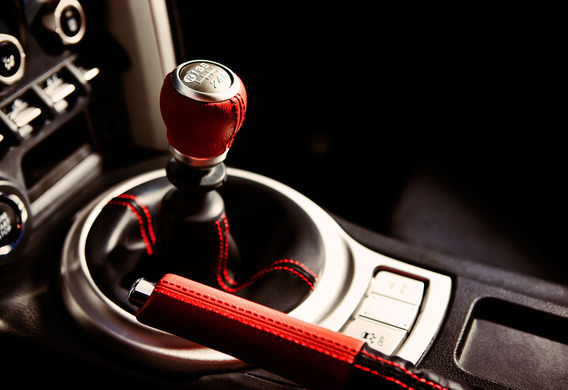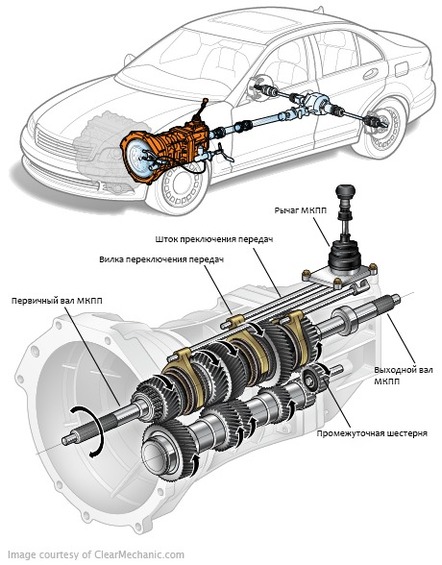
Any power installation consists of a power source and a transmission for the transmission of energy. In the automotive industry, transmission is referred to as either all the parts to transmit the torque from the motor to the wheels (that is, the gearbox, the actuators, the differential and the tp), or the transmission only. Why is it called "manual gearbox"?
Why is it called "manual gearbox"?
Using a mechanical box, the driver, pressing the pedal, blurring the clutch, and rearranging the lever in the position corresponding to the desired gear, that is, makes everything "hand", without any supporting mechanisms.
What are the mechanical boxes?
A normal manual gearbox allows the driver to switch from the first gear to the third or fifth gear. The special case is the so-called sequenced gearboxes that are used in the motor port. The Sequential box allows you to switch the gear only sequentially from one to the second, then to the third, and so on.
The merits of ICAP are that it allows the driver to choose the transfer in an arbitrary manner. For this, they are loved by athletes who use all the possibilities of a car
The basic equipment of modern automobiles may include a manual gearbox with five or six front gears and one tailback. The four-step boxes are not currently used, as they do not allow the use of all the features of modern engines. "Specialized" vehicles (e.g., sports cars) can have eight or more forward gears. The increase is justified by the need to transmit the torque to those limits which are effective for the vehicle. For example, if the engine produces a maximum torque at a low speed (which is typical of multi-cylinder engines such as V6, V8), it will only fall to high speed if the engine speeds up. To avoid this effect, increase the number of transfers. In this case, even if the maximum speed is reached at the highest gear, the engine continues to operate in its effective range.
A three-tiered manual three-tiered gearbox in the postwar years has earned the Americans the nickname "Three on the Tree"
By the way, this algorithm is correct in diametrically opposite conditions. For example, to overcome the speed of a police officer, it is necessary to slow down the speed and start to disperse the reduced gear that corresponds to the current speed.

History of mechanical transmission
The manual transmission is the first in history to transmit the torque available when the maximum speed of the vehicle starts to exceed the capability of the straight line, that is, the only transmission. It is assumed that the first prototype of ICCI was invented by Louis Panar and Emil Levassan at the end of the nineteenth century. Their mechanical transmission, as in the modern, used a set of gear wheels with different gear ratios for front gears and one gear for the rear.
In Cars Subaru Impreza WRX, Subaru Impreza WRX STI, the MIT switch is part of the set of tenets. For modern Porsche 911, the lever is available as an option
As it is now, the gears of the gears were reinforced on the secondary shaft, which moved along its axis, which allowed the different size of the jagged wheels to enter the clutch of a fixed gears on the primary shaft.
Unsynchronized and synchronized MCP
In the gearbox, so that there was no need to stop the car for gearshift, the gear was all in constant rotation. That decision at that stage of technical progress was the only one and, of course, its shortcomings. Only the perverse rotation of the gears allowed the transfer of the gear, or it would not have been possible to put them in the clutch of the gear. Naturally, the handling of such a "unsynchronized" gearbox required a lot of skill from the driver-it was necessary to switch gear on time-when the car reached a certain speed. Even so, however, the work of the box at the time of the switching was accompanied by the hearthrobbing scratcher that produced the gears, which did not immediately fall into the cordon.
The Tesla Roadster was originally planned to be equipped with a "pseudo" manual gearbox, but because of the complexity of the production, the manufacturer gave up this idea
In modern cars, thanks to the use of special devices called synchronizers, this problem has been reduced to a minimum. The essence of their action is that the gears are still constantly rotating, but at the right moment their rotation is stopped and they are fixed on the shaft. Then the gears, moving toward the lever, enter the cordon, and begin to spin again, already together. The modern synchronized box was first applied to Porsche 356, 1952. Conical synchronizers were installed in the box. This invention provided mechanical packages of similar design, which soon started to equip all cars, called "Type of Porsche". It opened the way to increasing the number of gears, and by the 1980s five-stage boxes, built on the same but improved structure, became the norm. The number of gears continued to rise and the Porsche 911 in 2012, for example, seven.
How the ICCP works
If we do not go into detail, the working principle of the ICIE is to connect the rotating input and the rest of the gross. In order to change the rotational speed of the output shaft, six gears with different gear ratios shall be used.
All parts of the gear box are in a single frame (crankcase), where they are continuously lubricating the transmission oil. The gear actuation shaft (sub-unit) between the six secondary (sub-known) shaft has been fitted.
The gears rotate freely on the rampart and the muffins are rigidly fixed to the rampart and rotate only with it, but they can move along its axis in limited space. For clutch couplings all gear located on the secondary shaft shall be fitted with a jagged crown. The couplets have a return jagged crown.
The device, called Overdrive, was originally used with the ICIE to save fuel on long overruns with constant high speed. In the future, the mechanism became part of the [ [ NPP]]
Synchronizers, which are also at the secondary shaft, do not allow the muff to block the freely rotating gear until the speed is equal to the speed of the leading shaft of the shaft. When this occurs, the gear is blocked and torque transmission through it begins.
gearbox position
The position of the lever may be different. Usually, in the rear-wheel-drive vehicles, the lower end of the lever is inserted directly in the carton lid or on the side, depending on the design.
If there is no option to insert the lever (and this is almost always the case in the front-wheel-drive vehicles), the extension cords are used. All the switches are inside the box and the extension of the extension cord depends entirely on where the lever is located.
Typically, the lever is either on the floor between the seats (in which case it is most often used without extension cords) or on the handlebars. There were other solutions in the history of the automotive industry, but they were all exotic and they didn' t come back.
Interesting facts about ICCP
According to one version, the idea of installing a mechanism on the car that allows to switch gear, the world owes a woman. The fact is that Bertha Benz, who had been in demand without her husband's car on August 5, 1888, went with the children of Mannheim to Pforzheim, where her mother lived. It was expected to cover a distance of 106 km. On the way there were several rises that the Benz car could not overcome without gearshift-it was simply glitches. It was only with the help of people who were pushing the cart from behind. When she returned, Bertha described the problem to her husband and suggested that the car be fitted with a device that would facilitate the work of the engine on the rise.







